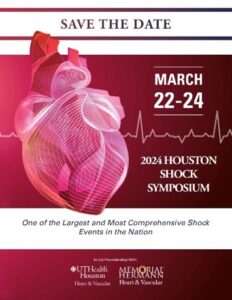Credit: Original article published here.
There is increasing recognition that left ventricle (LV) unloading is important for patients in cardiogenic shock supported by venous-arterial extracorporeal membrane oxygenation (VA-ECMO) – particularly, those in shock due to acute myocardial infarction (CS-AMI).1 Unloading the LV is commonly performed by inserting additional temporary mechanical circulatory support (tMCS), including devices like a percutaneous left ventricular assist device (pVAD, i.e., Impella®), CentriMag®, or an intra-aortic balloon pump.2
One approach to unload the LV during VA-ECMO that is infrequently used involves placement of a left-atrial drainage catheter that is placed via interatrial transseptal puncture. This would allow for direct left atrial drainage, thereby reducing pulmonary capillary wedge pressure and left ventricular preload thereby unloading the LV. This strategy is described as left atrial VA-ECMO or “LAVA-ECMO”.
During the 2023 Houston Shock Symposium, Dr. William W. O’Neill presented a case report about a patient with severe aortic regurgitation resulting in cardiogenic shock requiring the use of LAVA-ECMO as a bridge to definitive repair. Dr. Jeffrey Wang had a poster presentation on a case report on a patient with refractory cardiogenic shock initially cannulated with VA-ECMO as a bridge to heart transplant. However, the patient developed worsening pulmonary edema requiring conversion to LAVA-ECMO. In both cases, the placement of the left-atrial cannula assisted with pulmonary decongestion and reducing LV preload.
While this alternative approach to LV unloading has not been compared to other approaches, there are some practical advantages. When using LAVA-ECMO, there is no need for another large bore arterial access in addition to the cannulas required for VA-ECMO. Reducing the number of lines needed for access may decrease the number of complications and improve patient mobility. The strategy of LAVA-ECMO was brought up multiple times by panelists throughout the Houston Shock Symposium. Panelists also described some barriers in implementing LAVA-ECMO, particularly the difficulty in finding readily available cardiologists in performing transseptal puncture, particularly during nights and weekends. Solutions to this included identifying a small group of interventionalists or electrophysiologists skilled in transseptal puncture to perform this procedure.
When available, LAVA-ECMO is another strategy that should be considered that provides both cardiac output and LV unloading. While it is currently underutilized, there appears to be growing interest in its use during cardiogenic shock.
Dr. Jeffrey Wang is a cardiology fellow at Emory University and served as a CardioNerds Conference Scholar for the 2023 Houston Shock Symposium. To learn more about shock, enjoy the open-access Journal of Shock & Hemodynamics (JoSH), the official Journal of the Annual Houston Shock Symposium.
Save the date! The 2024 Houston Shock Symposium will be held in Houston, TX on March 22-24th, 2024.

References:
- Heusch G, Rassaf T. Left Ventricular Unloading in Myocardial Infarction. Journal of the American College of Cardiology. 2020;76(6):700-702. doi:doi:10.1016/j.jacc.2020.06.032
- Donker DW, Brodie D, Henriques JPS, Broomé M. Left ventricular unloading during veno-arterial ECMO: a review of percutaneous and surgical unloading interventions. Perfusion. Mar 2019;34(2):98-105. doi:10.1177/0267659118794112


